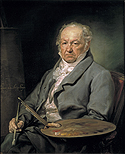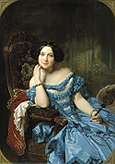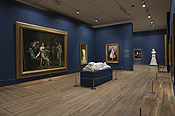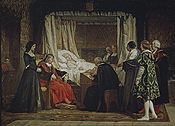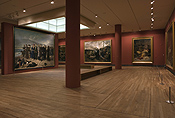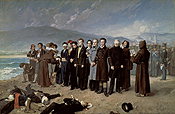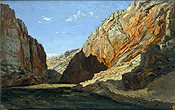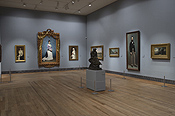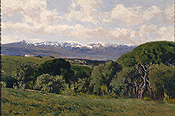The browser will either open the file, download it, or display a dialog.
|
El siglo XIX en el Prado [The Nineteenth Century in the Prado] Catalogue: |
||||||
|
Last autumn, after six years of construction and remodelling work that was preceded by heated polemic, the Museo del Prado opened its new building extension around the area of the Convento de los Jerónimos. Designed by the architect Rafael Moneo, the winner of an ad hoc international competition in 1998, it is the most important transformation of Juan de Villanueva’s 1785 building, originally created for the Academy of Natural Sciences, and subsequently converted into the Real Museo de Pinturas y Esculturas in 1819. The idea to modernise the Museo del Prado, placing it on a par with the leading museums of the world, has been a preoccupation for the successive governments of the post-Franco era. The museum’s new director Miguel Zugaza seems to have given a definitive impetus to this aspiration. The current extension is one the most significant steps in the transformation of the Prado, with other important ones planned for the coming years. |
|||||||
|
The choice of nineteenth-century Spanish art for the inaugural exhibition is particularly relevant, since this is a period that is poorly known, and seldom appreciated, at home and abroad. The large show The Nineteenth Century in El Prado was scheduled to last for almost six months, from October 2007 to April 2008. Meanwhile, the galleries of the original Villanueva building housed two other exhibitions on old masters of the Spanish School, one on Velázquez’s Fables. Mythology and Sacred History in the Golden Age (November 2007 – February 2008), and the other on El Greco in El Prado (December 2007-February 2008). Such a coincidence is neither neutral nor innocent. The simultaneous exhibition in the Prado Museum of a towering figure like Velázquez and of nineteenth-century art seems to echo the 2003 show Manet en el Prado that focused on the reception of the Siglo de Oro painting by the French avant-garde, led by Edouard Manet, in the 1860s. Last but not least, The Nineteenth Century in El Prado was immediately followed by a major exhibition on Francisco de Goya, namely Goya in Times of War (April, 15 – July, 13 2008). Thus, the schedule of exhibitions following the inauguration of the new Prado has brought together Spanish art of the nineteenth century and the painting of three of the greatest masters of the Spanish school, Velázquez, El Greco, and Goya. Significantly enough, all of them have had a profound influence in the art production of the nineteenth century, Velázquez at an earlier stage, El Greco and Goya in the later decades. |
|||||||
|
This exhibition on nineteenth-century art followed a new orientation at the Prado: to showcase art of the recent past while linking it to the tradition of the old Spanish School. In this case, the exploration of the dialogue between the art of the Golden Age and that of the nineteenth century has been one of the guiding concepts. A more radical example of this position was the 2006 exhibition, Picasso. Tradition and Avant-garde, which opened the Prado Museum to modernity through an analysis of Picasso´s reception of the Spanish old masters held in the museum´s collection. |
|||||||
|
The history of the nineteenth century collection owned by the Prado is both complex and problematic. An initiative of King Ferdinand VII and his second wife, Isabel de Braganza, the Museo Real was founded in order to exhibit a selection of the Spanish royal art collections to a wider audience and to artists. From the very beginning, contemporary art was given a place in the museum, and soon after its creation, a Sala de los Contemporáneos was opened with paintings by Goya, who was still alive at the time, and by several of his contemporaries—José de Madrazo, for example, who was to become its director in the years to come. |
|||||||
|
The necessity of housing works of art obtained through the nationalization of the Church patrimony in 1835-1836 led to the creation of the Museo Nacional de la Trinidad in 1838. By the mid-nineteenth century, the museum also had to accommodate the acquisitions of the state, mostly huge history paintings from the Exposiciones Nacionales de Bellas Artes, the official exhibitions of contemporary art begun in 1856 after the model of the Parisian Salons. Ultimately, in 1872 the Museo Real and the Museo de la Trinidad were unified and thus the Museo Nacional del Prado was created. Due to lack of space, many of the works held at the Museo de la Trinidad were deposited in provincial museums and other official institutions. In the thirty years between 1866 and 1896, over 300 works were sent to administrative buildings, universities, hospitals or libraries in addition to museums. This dispersion of art works ultimately led to the long delayed opening of the Museo de Arte Moderno in 1896. This museum was to contain the work of “the most outstanding Spanish artists since the extinction of the old regional schools, whose last and exceptional blossoming is represented by D. Francisco de Goya” (444). Further acquisitions for the collections of both nineteenth and twentieth century art followed until 1951, when the two collections were given separate museums: the Museo Nacional de Arte del siglo XIX, and the Museo de Arte Contemporáneo. |
|||||||
|
Finally, in 1971, the collections of nineteenth-century painting and sculpture reentered the Museo del Prado. They were housed and partially exhibited in the Casón del Buen Retiro, a remnant of the old royal palace of the same name, close to the Villanueva building. Substantial rearrangements of the collection on display proved necessary with the arrival in 1981 of Picasso´s Guernica in the Casón—and yet again in 1992 when it was transferred to the Centro de Arte Reina Sofía where it remains today. In 1995, the nineteenth-century public collections were divided between the two major national museums. A government decree established 1881—Picasso´s birth date—as the criterion for reassignment. Thus, works of artists born after 1881, even if previously held at the Prado, were to be included in the collections of the Centro de Arte Reina Sofía. This transfer of works of art from one institution to the other involved many exceptions, such as Darío de Regoyos (b.1859), Santiago Rusiñol (b.1861), and Ramón Casas (b.1866). The Casón del Buen Retiro closed its doors in 1997 and has just reopened after an extensive renovation, including the restoration of the ceiling decorated with a fresco by Luca Giordano. It is now intended to function as a research center and not as a museum space. |
|||||||
|
Although the public historically showed only marginal interest in the Casón collection, it has been literally invisible for the last ten years while it was stored away in Alcalá de Henares near Madrid. The exhibition in El Prado thus offered the public an opportunity to reacquaint itself with the painting and sculpture produced by Spanish artists of the nineteenth century—or at least to approach it in a novel and unprejudiced way. In fact, Spanish art of the nineteenth century has long been relegated to a Cinderella role; it is clear that this is now changing. Central to the institutional project of the new Prado is the planned reorganization of the entire collection as soon as more room becomes available in the Villanueva building. Much of the space is to be occupied by the nineteenth-century Spanish art on view in this exhibition, which will then be displayed in the permanent galleries of the museum. |
|||||||
|
This is a way of facing what was an unsatisfactory situation as well as of acknowledging how insufficiently known, and even misunderstood, the Spanish art of nineteenth century has been. This is not to say that studies or exhibitions on individual artists or on specific genres, such as landscape or portraiture, have been lacking. Indeed, exhibition programs of museums in Madrid and other Spanish cities regularly include shows on art of the nineteenth century, especially of the fin-de-siècle decades, in which major figures are revisited and often situated at an international level. Such was the case for the Sorolla / Sargent show last year at the Thyssen-Bornemisza Museum. Nevertheless, the last major shows surveying Spanish painting of the whole century was held at the Museo de Arte Contemporáneo (though organized by the Prado) sixteen years ago in 1992. Under the title La pintura de historia del siglo XIX en España, it was devoted exclusively to history painting, and it was curated by José Luis Díez who was also responsible for the present show, together with Javier Barón, both currently chief curators of Modern Painting at the Prado. To this day, few exhibitions held in the Prado have been consecrated to nineteenth-century Spanish artists. As exceptions to this rule, one can mention the show on Carlos de Haes (2002), the pioneer of realist landscape painting in Spain, and the exhibition on the art collector Ramón de Errazu, Fortuny, Madrazo y Rico. El legado de Ramón de Errazu (2006). With this inaugural exhibition, the Prado apparently had two goals: to promote Spanish art of the nineteenth century and, consequently, to promote its own collection. Indeed, the museum has shown a canonical selection of its holdings of painting and sculpture of the nineteenth century, thus dignifying a part of its collection that had suffered too long from provisional acceptance and disregard. This is also the case for the exhibition now in Toledo, The Spanish Portrait in El Prado: from Goya to Sorolla, that focuses on nineteenth-century portraiture. |
|||||||
|
In general, Spanish painting of the nineteenth century is almost unknown outside Spain, and in comparison with that of other European countries or the United States, it is little addressed either in international research or in academic production. To speak of an “invisibility” of Spanish art is thus no overstatement—nor would it be such even in Spain. It is commonplace to see nineteenth-century Spanish art as somehow dwarfed or squeezed by the gigantic figures of Francisco de Goya, on the one extreme, and Picasso on the other. It seems as if there is a vacuum, a sort of black hole, after the death of Goya. At the end of the century, the figure of Picasso would rescue Spanish “genius” after decades of decay and obscurity. Indeed, the decline of the Spanish school after Goya was an accepted opinion by the mid-nineteenth century. For instance, when confronting the work of Spanish artists shown at the Universal Expositions of 1855 and 1867, French critics tended to resent its lack of originality and independence. The comparison with the Spanish School of the seventeenth century was always unfavorable: contemporary Spanish painting appeared to the eyes of critics as different as Maxime Du Camp, Théophile Gautier or Etienne Délecluze, as excessively dependent on its French counterpart, and thus unable to express its own national character. For example, Gautier declared that Goya was the last of a race of true and original artists, that of Velázquez, Murillo, Zurbarán and Ribera. This perception of Spanish art of the nineteenth century as an interlude without genuine interest has proved extraordinarily persistent, a stigma that has distorted both its appreciation and its interpretation; hence, the relevance of the curators’ aim at linking the painters of the nineteenth century to their predecessors in the Golden Age. |
|||||||
|
Related to this is the idée reçue concerning the quality of Spanish art of this period; that is, as a production that does not stand comparison with other national schools whether French, English or German. From the perspective of modernism, Spanish art of the nineteenth century is retardataire, since it incorporates foreign artistic innovations with considerable delay, and after their radicalism had been tamed. Such is the case with the late introduction of romanticism and with the particular brand of impressionism developed by Joaquín Sorolla at the turn of the twentieth century. Nevertheless, Spanish artists were not producing in a context that was resistant to influences from abroad. On the contrary, one of the points made clear by the research involved in this exhibition is the importance of the international art centers of Paris and Rome for Spanish artists throughout the century. While many journeyed to Rome, long before the foundation of the Academia de Roma in 1873, many others travelled to Paris, staying with well-established (and official) masters, and participating in Salon exhibitions and in the different Universal Expositions of the second half of the century. |
|||||||
|
It is clearly an opportune moment to make a critical reassessment of Spanish art of the nineteenth century, analogous to the recent reappraisal of Scandinavian art of the same period, through exhibitions and academic publications. Exhibitions such as The Nineteenth Century in El Prado offer more than the possibility of making it available to wider audiences, with a favourable display and a clear, didactic discourse. More than simply updating our knowledge, the challenge of the show was—or should have been—its invitation to approach and interpret the specificity of nineteenth-century Spanish art according to a new set of criteria. |
|||||||
|
The Museo del Prado’s extraordinary collection of nineteenth-century Spanish art amounts to almost 3,000 works, the vast majority of which are paintings, many in storage or deposited in provincial museums or official buildings. The present exhibition showed a careful selection of ninety-five paintings, from Goya to Joaquín Sorolla, along with a disproportionately poor representation of twelve sculptures. Significantly, neither drawings nor engravings had been included in the show. Some paintings not displayed in the Casón del Buen Retiro, such as José de Madrazo´s allegory Divine and Profane Love (1813) were exhibited at the Prado together with some of the museum’s very recent acquisitions, such as two genre paintings by Leonardo Alenza. |
|||||||
|
When selecting the works to be shown, the curators´ criteria was based on quality; thus their concern was to choose the best of the holdings and to display them in the best possible way. This focus on excellence and quality was apparent even in the material aspects such as the state of conservation of both canvases and frames, some of which were original and in several cases, spectacular. |
|||||||
|
The selection of artwork was also representative of the variety of the art created in Spain, offering an overview of the major trends and figures of this period. The exhibition was displayed in three large, functional, and well lit rooms, two of them divided into four sections, and occupying the ground and first floors of the museum’s addition. Formal quality and a sometimes overwhelming technical mastery were enhanced by an austere layout. Explanatory panels were reduced to a minimum; additional information was provided by a small booklet with comments on each work on view, which was distributed upon entering the exhibition. |
|||||||
|
The three rooms were painted in different colours. Those on the ground floor were more intense: deep blue for neoclassic, romantic and academic painting and Pompeian red for history painting. The realist and naturalist paintings on the first floor were hung on walls painted pale blue. Such an interruption in the spatial continuity helped to make the transition to the brighter room upstairs, which seemed entirely appropriate to the more modern works on view there. |
|||||||
|
The exhibition was divided into nine sections following a chronological order, from the disciples of David, José de Madrazo and Juan Antonio Ribera, to fin-de-siècle figures such as Joaquín Sorolla and Aureliano de Beruete. However, this strict chronological linearity was problematic since dates ended up being an arbitrary criterion: why was there no painting by Goya prior to 1805, when the exhibition closed with works of the first decade of the twentieth century? |
|||||||
|
Under the title “Goya and Neoclassicism”, the first section of the show exhibited portraits and history paintings (fig. 1). Three portraits by Goya—one for each decade of the century—faced two large history canvases by Ribera and Madrazo, the most representative examples of Spanish neoclassicism. The portrait of an elderly Goya by the then-director of the Museo Real, Vicente López, was of particular note (fig. 2). The section devoted to Romanticism brought together a wider variety of genres. A single landscape by Genaro Pérez Villaamil, the most prominent master of this genre, was hung in the company of small-scale “goyesque” canvases by Goya´s followers Leonardo Alenza and Eugenio Lucas. A group portrait by Antonio Maria Esquivel showed a prominent collection of writers and poets listening to José de Zorrilla in the painter’s studio. This emblematic depiction of Madrid intellectual life during the reign of Queen Isabel II could well be the local equivalent to images of gatherings in the artists’ ateliers as places of sociability: the place where the artist not only works, but also emerges as a social persona. |
|||||||
|
Six large portraits of members of high society, mostly aristocrats, by Federico de Madrazo, one of the future directors of the Museo del Prado, dominated the space devoted to “Academic Purism”. Particularly noteworthy was the portrait of the Countess of Vilches (1853) reminiscent of French portraiture of the period, and of Ingres in particular (fig. 3). The accomplished rendering of this charming young woman, in her fashionable pale blue dress, with her fresh smile and natural gesture, was used in the promotional poster of the exhibition. It stood in contrast with the formal portrait of the aristocrat Isabel Álvarez Montes, almost excessive in both the lavishness of the composition and the technical skill of the artist. A large Nazarene-influenced canvas representing an obscure scene of the Virgin and Saint John journeying to Ephesus after the death of Christ (1862) was on view after careful restoration, together with several genre paintings by Valeriano Domínguez Bécquer that recorded popular types and traditions of the regions of Spain. A Young Boy Seated (1859) by Víctor Manzano recalled Velázquez and Murillo in both its naturalism and the sobriety of its color and composition. |
|||||||
|
The first room to be exclusively consecrated to an individual artist, and one of the most accomplished spaces of the exhibition, showed the work by the short-lived Eduardo Rosales (fig. 4). It reflected the pivotal position of this painter in modern Spanish art. In comparison with the previous sections, a change of quality was apparent in the selection of eight canvases of different genres, ranging from history painting to portraits as well as a nude, all of them produced in scarcely a decade between the late 1850s and the early 1870s. Rosales’ painting, which introduced a brand of realism based on the work of Velázquez, represented a significant shift in Spanish art. The two large history canvases, both winners of the highest prizes at the Exposiciones Nacionales, were especially remarkable. Queen Isabel la Católica dictating her Will was not only a huge success at the exhibition of 1864, but also at the 1867 Universal Exposition of Paris, while The Death of Lucretia (1871) received a polemical reception at home because of the audacity of its technique of broad and loose brushstrokes (fig. 5). The full-length portrait of Concepción Serrano as a teenager in her pink silk dress was an homage to both Velazquez and Goya. In the middle of the space stood a sculpture of Lying Christ (1872) by Agapito Vallmitjana, that echoed the deathbed scene of Queen Isabel; Rosales himself sat as the model, thus making the presence of the painter implicit among his paintings. |
|||||||
|
The historical depictions of Isabel la Católica and Lucretia, two episodes with a significant political dimension, linked the section devoted to Rosales to the next section, entirely dedicated to history painting and the most spectacular room in the whole exhibition (fig. 6). Twelve huge canvases by ten painters, real grandes machines depicting mostly somber and dramatic subjects, covered the red walls. The paintings were all produced for the Exposiciones Nacionales between 1864 and 1889, the heyday of those official productions before the importance of the genre declined sharply in the mid-1890s. |
|||||||
|
Apart from two examples of scenes taken from ancient history (a Death of Seneca exhibited in strong competition with the Lucretia submitted by Rosales the same year) and from religious history (a Burial of Saint Sebastian, by Alejandro Ferrant, 1877), the majority of images were drawn from Spanish history. The themes ranged from the Middle Ages and the epoch of the Catholic monarchy of Fernando and Isabel to contemporary times. Conspicuously absent were some of the most ubiquitous subjects in official history painting, such as Columbus and the discovery of America, or the fall of Granada and the victory of the Christian Reconquista over the Muslim presence in Spain. The Expulsion of the Jews from Spain in 1492 by Emilio Sala (1889) was one of the most significant events of the reign of the Catholic kings to be represented in the show. |
|||||||
|
Directly inspired by Velázquez´s Rendición de Breda was José Casado del Alisal’s canvas celebrating the first Spanish victory over the French in the War of Independence (1808-1814), the Surrender at Bailén (1864). He also depicted the gruesome legendary episode of the twelfth century King Ramiro II of Aragon, in the company of his noblemen, contemplating in horror the severed heads of the traitors whose execution he had ordered. The huge canvas is a spectacular, yet perhaps empty, example of the painter’s mastery of his métier and his skills in scenographic composition. Contemporary history is the source for Antonio Gisbert´s Execution of Torrijos and his Companions on the Beach at Málaga (1887-1888), the representation of the tragic outcome of a liberal conspiracy against Ferdinand VII in 1831 (fig. 7). Commissioned by the liberal government then in power, and possibly one of the most outstanding works on view, with its moral tension and the modernity of the cropped corpses and the fallen top hat on the foreground, it was given a highly visible place in the room. |
||||||
|
The alliance of madness and love, much in the romantic vein of the time, could explain the popularity of the story of Juana la Loca, the allegedly insane daughter of the Catholic kings. Two canvases devoted to her were on view, in particular Francisco Pradilla´s iconic Juana la Loca (1877) showing the queen with her husband’s coffin as she paused to rest on her journey to Granada for his burial. Literary or legendary sources inspired paintings such as The Lovers of Teruel (1884) by Antonio Muñoz Degrain. In the end, many of the paintings came closer to oversized representations of genre historique, which combined a taste for historical accuracy, naturalistic rendering and technical mastery. |
|||||||
|
The special place devoted to this artistic genre in the exhibition discourse deserves to be noted here. By the sheer size of the canvases and by the impressive layout of the room, history painting was the evident protagonist of the show. Its centrality in the artistic production during the second half of nineteenth century in particular is a phenomenon entirely specific to Spain. That is to say that official art was given an extraordinary visibility through the much publicized Exposiciones Nacionales, as well as a definite prominence over independent developments that led to the emergence of modern art elsewhere in Europe. The exhibition made the importance of the state-patronage system manifest, which promoted an academic and conservative style in both painting and sculpture. At the same time, it disclosed how extensively artists depended on it to shape their public careers. Indeed, the Exposiciones Nacionales, with their prestigious prizes, the acquisitions for public collections, and the consequent display in national museums or in official buildings, proved essential for the artists as the place of their consecration. As one can expect, first prizes went to historical canvases that attracted the attention of the juries, the critics, and the audiences through dramatic compositions depicting historical episodes, through declamatory gestures and a melodramatic rhetoric that carried straightforward messages. |
|||||||
|
In fact, the prominence of official and state-controlled institutions was not counterbalanced, at least until late in the century, by an independent art network as it was the case in other European countries and the United States. In Spain, the historical and social conditions throughout the nineteenth century made the emergence of a sound private art market, with galleries and collectors, problematic. Equally difficult to assess is the relevance of artistic societies such as the French Sociétés d´Artistes or of alternative educational institutions. Finally, the role of art criticism in the reception of contemporary art, linked to the development of a specialized press, did not have the significance that this phenomenon had in France or in England. |
|||||||
|
In sharp contrast to the heavier, sometimes exceedingly impressive, atmosphere of the rooms on the ground floor, the ambience of the gallery upstairs was lighter in all respects. The pale blue walls, the smaller scale of the works, the luminosity of their palette, and the often mundane scenes depicted contributed to this impression of brightness. The first section was dedicated to landscape painting thus acknowledging the key role played by this genre in exposing Spanish painting to modernity. Landscape had an important public success in the official Exposiciones, where it was abundantly represented, even though not regularly awarded. Two of the most important contributions were from the Catalan, Ramón Martí Alsina, who was acquainted with French realism through his first-hand contact with Courbet and the Barbizon School; and from the Belgian-born Carlos de Haes, the father of Spanish modern landscape. On view in this section were a large painting of a mountain landscape in northern Spain, and four studies executed outdoors in a single session by De Haes, together with canvases by Martí Alsina and by Muñoz Degrain, still romantic in sensibility (fig. 8). |
||||||
|
With so pivotal a role, landscape painting perhaps deserved a more generous treatment in terms of space and prominence. For example, the Prado museum owns a large number of works by Carlos de Haes, donated by his pupils, among them almost 200 plein-air oil studies of landscapes from different regions of Spain, France and Holland. Only four of them, so essentially modern in their sketchiness and their directness, were exhibited—and possibly not in the most favourable way—something that was particularly disappointing. |
|||||||
|
A battle painting of the North African military campaigns of the early 1860s was the link with the next section devoted to Mariano Fortuny, one of the most internationally renowned Spanish painters of the century. Most of Fortuny’s paintings were from the last years of his life in the early 1870s. They are small canvases or panels with genre scenes, some intimate in mood, in the orientalist taste popular at the time, or following the new Japanese fashion. The virtuosity and the refinement of his technique, his handling of light effects, as in the diminutive Nude Boy on the Beach of Portici (1874), made Mariano Fortuny one of the most sought-after painters among the wealthy art-collecting bourgeoisie. The circle of artists around Fortuny included Martín Rico y Ortega and Raimundo de Madrazo. Four landscapes by Martín Rico presented important stylistic differences: from the realistic depiction of the shores of the river Oise, vaguely reminiscent of Daubigny, and the orientalist view of the Alhambra gardens, to the panorama of Paris from the Trocadéro terrasse. In contrast, Raimundo de Madrazo was a portraitist of the Parisian grand monde, in particular upper class women and wealthy Spaniards living there; he would later be popular among American elites as well. Two impressive portraits dominated this section, that of the Marquesa de Manzanedo and of her friend, the art collector, Ramón de Errazu, owner of the most outstanding paintings by Fortuny and Martín Rico, which he donated to the museum with the rest of his collection (fig. 9). |
|||||||
|
The section entitled “From Realism to the End of the Century” was rather eclectic in its gathering of diverse works and painters, ranging from the naturalist genre scenes by José Jiménez Aranda and the portraits by Ignacio Pinazo to the huge canvas depicting an emphatic historical anecdote by Muñoz Degrain—a sort of monumental genre scene in the style of academic naturalism. Joaquín Sorolla´s naturalist And They Still Say Fish is Expensive (1894), an image denouncing the labor conditions endured by the poor, is included in the final section of the exhibition. The canvas is the only example of naturalist painting dealing with social concerns in the show, although this was a visible trend in the works submitted to the National Exhibitions at the end of the century. |
|||||||
|
The show closed with a selection focused on the work by Sorolla and his friend, the landscapist Aureliano de Beruete. Both are major figures of late nineteenth-century painting, contemporary with other artists present in the collections that have been transferred to the Centro de Arte Reina Sofía. Four splendid portraits by Sorolla were included, among them one of Beruete’s son, a future director of the Museo del Prado, and one of the actress María Guerrero dressed as the Infanta Margarita, based on the Velázquez painting in the museum’s collection. One of Sorolla´s scenes of the luminous beaches of his native Valencia, Boys on the Beach (1910), was on view together with Beruete’s landscapes of the outskirts of Madrid, such as a La Pradera de San Isidro (1909), a place represented by Goya more than a century earlier. There was also a view of the snowy mountains of the Sierra del Guadarrama, a reference point for scientific and cultural societies such as the Institución Libre de Enseñanza, which was to lead intellectual reforms in Spain up to the Civil War (fig. 10). The exhibition ended with the Guadarrama Mountains, a last homage to Velázquez who often depicted this landscape as the background to his portraits. |
||||||
|
Although the exhibition seemed to follow a strict chronological order, the general impression was that there were in fact interferences and inconsistencies in its lineal narration. Thus, some sections were focused on major figures (for example, Madrazo, Fortuny, or Sorolla) or even exclusively devoted to a painter, such as Eduardo Rosales. In other cases, the artistic genre was the criterion as for the galleries devoted to history painting or landscape, but historical canvases and landscapes were to be found also elsewhere in the show. In addition, other sections were organized according to style such as those on neoclassicism, romanticism or realism. |
|||||||
|
As for the catalogue, it has the same encyclopaedic breadth as the exhibition. Lavishly illustrated, it is almost 500 pages in length, with substantial entries for each work, the result of careful and documented research. It includes an appendix with biographical notes on all artists exhibited and an updated bibliography. A long introductory essay by Javier Barón, one of the curators, retraces the evolution of Spanish painting and sculpture from Goya to Picasso while an article on the history of the nineteenth-century collections by the Prado curator Ana Gutiérrez Márquez closes it. Barón´s survey, and the entries as well, were based on stylistic distinctions and precise formal analysis of individual paintings and sculptures. Gutiérrez Márquez’s article, although placed at the end, is a central contribution to this publication since it discusses one of the most important issues raised by the show. Indeed, the reconstruction of that particular history makes clear how precarious the public visibility of the collection has been in the last two centuries, and how secondary in status and interest it was—even within the Prado itself. |
|||||||
|
Barón´s essay includes the discussion of artists and works that were not exhibited (though illustrated in many cases), some even beyond the Prado’s holdings, such as fin-de-siècle painters like Ignacio Zuloaga, Santiago Rusiñol or Joaquim Mir—not to speak of Picasso, whose Woman in blue (1901) closes the text. This brings to mind one of the most immediate dysfunctions of the show, which in fact is a problem of the museum’s collection itself. The exhibition ends abruptly, and so does the Prado collection, according to criteria which are neither properly artistic nor historical (as the date of 1914 is for the Musée d´Orsay) but simply biographical, 1881 being the birth date of Pablo Picasso. As the government decree of 1995 puts it in peculiar administrative prose, Picasso´s figure and work, “because of its recognized genius and relevance beyond the limits of the merely aesthetical, can serve to determine what comes before and what comes after in the artistic evolution of the last two centuries” [“…por su reconocida genialidad y su trascendencia más allá de lo puramente estético, pueda servir para determinar el antes y el después de la evolución artística en los dos últimos siglos.” Royal Decree 410/1995, March 17]. Indeed, the criterion for the exceptions to this rule, that is the artists born between 1850 and 1880, was based on the presumed “special characteristics” manifest in their work, and seems even more arbitrary and questionable than Picasso´s birth date for assignment to one national museum or the other. As Barón´s essay is implicitly stating, the closing of the exhibition with Beruete and Sorolla was artificially forced, as some of their contemporaries whose work is essential for a proper grasp of Spanish art of the late nineteenth century are in the collections of the Centro de Arte Reina Sofía only since 1995, and for this reason alone were excluded from the show. |
|||||||
|
As a whole, the exhibition, together with its catalogue, could be seen as a clear example of the confrontation of the practices of art history in the museum and at the university, not far from the tension between museum curatorial research and academic scholarship addressed at in the 1999 Clark Conference on The Two Art Histories. In fact, The Nineteenth Century in El Prado has been a project headed in every aspect of its development by the museum that owns the collection, and its curators are also the editors and authors of the catalogue. No invitation, whether national or international, seems to have been made outside the institution, whether to university professors or independent scholars—with the exception of an international colloquium of curators from Europe and the United States. Neither the exhibition nor the accompanying publication aimed at offering an interpretative approach to the art produced in Spain during the nineteenth century. As mentioned previously, the primary goal of the curators was to bring to light the formal and technical quality of the selected art works, to let its “aesthetic dimension” manifest itself. The exhibition discourse followed this stance with great coherence, and the catalogue was not concerned with theory, even less with critical approaches, but with documenting the research carried out for each individual work. |
|||||||
|
Indeed, several significant issues are left open in both the exhibition and the catalogue, which should be the focus of art historical investigation. Chronology and style, the artist and the work of art separated from social life, from politics and history, are categories of art historical discourse that have been largely displaced by other conceptual frames of analysis and interpretation—at least in certain academic milieus. For example, the issue of gender was left undiscussed—unmentioned in the catalogue entries—even though the images of women were ubiquitous, from portraits of aristocratic ladies, to the voyeuristic fantasies of a Slave on Sale (Jiménez Aranda, 1897) or the bound nude bodies of the daughters of El Cid (Dióscoro Puebla, 1871). Discarding gender appears to be an inadequate option given the context of a patriarchal society such as that of nineteenth-century Spain, with the pressure of the Church on sexual morals and the relegation of women from the public sphere. Another aspect that could have been taken into account relates to the social identity of the artist, and its construction in this period, since a significant number of portraits of artists, writers, actors and even museum directors, hung on the walls. |
|||||||
|
But the most conspicuous omission in the show, and in the catalogue, was that of the historical and the ideological dimensions. In the nineteenth century, Spain had an especially turbulent political and social history. Declining international significance, civil wars subsumed by wars of succession, changes of regime from monarchy to republic and vice versa, reactionary social elites, and the weight of institutions such as the Church made the country exceptionally resistant to modernization and progressive innovations. This situation contrasted with that of leading European states like the United Kingdom, France, or Germany. In addition to this, Spain was in the process of constructing itself as a modern national state. History painting, that most official of all genres, contributed to the fabrication of an ideological discourse aimed at making the existence of a Spanish nation credible–an issue which is still open to controversy. With the representation of specific moments and personalities of the Spanish national past, history painting became a politically loaded genre of rare public effectiveness. Thus, it helped to fulfil the need to legitimate a presumed national identity, which would allow contemporary Spaniards to think of themselves as members of a united community with a shared history, culture and tradition. In recent decades, nineteenth-century history painting has been the subject of reassessments that have questioned a modernist discourse that based aesthetic interest on rupture and innovation. The revision of this genre in Spain was already apparent in the previously mentioned 1992 exhibition, La pintura de historia del siglo XIX en España. The present show in the Prado was thus a confirmation of the importance of this path-breaking approach, which recognized the inherent values of a type of painting considered too close to academic precepts in terms of both technique and concept. Nevertheless, in the Prado exhibition, the notion of history painting as ideology, free of the prejudices of modernism, deserved a more substantial reflection. |
|||||||
|
History, politics, ideology: significantly, none of these issues were addressed in an exhibition that was staged as a succession of artworks highlighting the sustained and even brilliant skills of the artists. However, the question immediately arises as to whether this is a sufficient intellectual foundation for an exhibition whose immediate ambition should have been to place nineteenth-century Spanish art under the focus of international research. The catalogue could have provided room for updated approaches to art historical investigation beyond the limits of traditional practices and discourses. |
|||||||
|
One can end by saying that identity was indeed addressed in the exhibition, but only by way of artistic identity. Something omnipresent both in the exhibition and the catalogue was the existence of a given Spanish pictorial tradition that ensured the continuity from the masters of the Golden Age to the painters of the nineteenth century. As Barón points out in the opening pages of his essay, it is the guiding thread of Velázquez that unites Goya to the fin-de-siècle painters. Velázquez is probably the name most often repeated in the catalogue and the artistic reference most conspicuous in the show, from the numerous portraits to Rosales’ canvases or the landscapes by Beruete. The presence of Goya at the beginning of the exhibition was a way of underscoring that connection. Thereby, the institution itself was put, in a rather oblique way, at the center of the exhibition’s conceptual framework: the Museo del Prado, the keeper of that Spanish pictorial tradition, appears to be an important instrument for the artistic creation of the nineteenth century. The focus on Velázquez, and thereby on the Prado itself, was also an indirect way of bringing Spanish nineteenth-century painting closer to European modern art. Velázquez was indeed a reference for both Spanish artists and avant-garde painters such as the French, for example, and the Prado was a point de rencontre in their shared interests. But if raised at any stage of the show, the question of how “modern” Spanish art of the nineteenth century was, or could have been, is left unanswered. Velázquez probably did not have the same meaning for Edouard Manet as he did for Eduardo Rosales. To examine this difference with an unprejudiced vision, to investigate the conditions as well as the limitations of the art production of nineteenth-century Spain, is the challenge put forth by the exhibition The Nineteenth Century in El Prado. |
|||||||
|
Isabel Valverde |
|||||||



